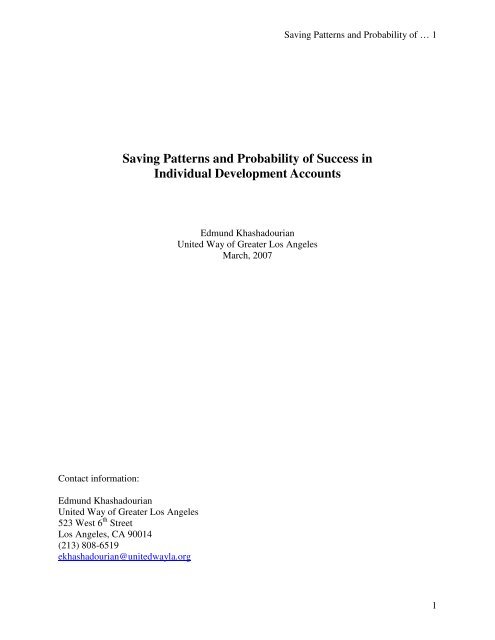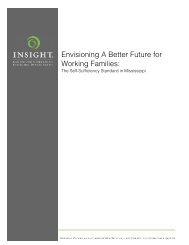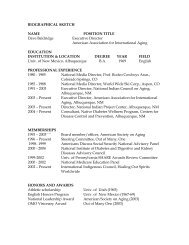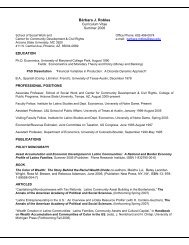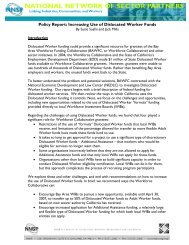Saving Patterns and Probability of Success in Individual ...
Saving Patterns and Probability of Success in Individual ...
Saving Patterns and Probability of Success in Individual ...
Create successful ePaper yourself
Turn your PDF publications into a flip-book with our unique Google optimized e-Paper software.
<strong>Sav<strong>in</strong>g</strong> <strong>Patterns</strong> <strong>and</strong> <strong>Probability</strong> <strong>of</strong> … 1<br />
<strong>Sav<strong>in</strong>g</strong> <strong>Patterns</strong> <strong>and</strong> <strong>Probability</strong> <strong>of</strong> <strong>Success</strong> <strong>in</strong><br />
<strong>Individual</strong> Development Accounts<br />
Edmund Khashadourian<br />
United Way <strong>of</strong> Greater Los Angeles<br />
March, 2007<br />
Contact <strong>in</strong>formation:<br />
Edmund Khashadourian<br />
United Way <strong>of</strong> Greater Los Angeles<br />
523 West 6 th Street<br />
Los Angeles, CA 90014<br />
(213) 808-6519<br />
ekhashadourian@unitedwayla.org<br />
1
<strong>Sav<strong>in</strong>g</strong> <strong>Patterns</strong> <strong>and</strong> <strong>Probability</strong> <strong>of</strong> … 2<br />
<strong>Sav<strong>in</strong>g</strong> <strong>Patterns</strong> <strong>and</strong> <strong>Probability</strong> <strong>of</strong> <strong>Success</strong> <strong>in</strong> <strong>Individual</strong> Development Accounts<br />
Abstract:<br />
An ample body <strong>of</strong> literature has formed analyz<strong>in</strong>g the demographic attributes <strong>of</strong> savers <strong>and</strong> their<br />
impact on sav<strong>in</strong>gs outcomes <strong>in</strong> IDA programs. But <strong>in</strong> the absence <strong>of</strong> detailed sav<strong>in</strong>gs data<br />
samples from different IDA programs, the impact <strong>of</strong> certa<strong>in</strong> structural factors (such as conditions<br />
set forth <strong>in</strong> a typical IDA sav<strong>in</strong>gs plan agreement, <strong>in</strong>clud<strong>in</strong>g the required frequency <strong>of</strong> deposits,<br />
length <strong>of</strong> the sav<strong>in</strong>g period, etc.,) has not been extensively studied. This article puts forward the<br />
simple hypothesis that regular savers, regardless <strong>of</strong> their demographic backgrounds, average<br />
monthly deposits, <strong>and</strong> type <strong>of</strong> deposits (i.e., automatic or otherwise), st<strong>and</strong> a better chance <strong>of</strong><br />
reach<strong>in</strong>g their sav<strong>in</strong>gs goals. The methodology employed <strong>in</strong> this article differs from other studies<br />
<strong>in</strong> that <strong>in</strong> lieu <strong>of</strong> expla<strong>in</strong><strong>in</strong>g Average Monthly Net Deposits (AMND), it is focus<strong>in</strong>g on<br />
completion <strong>of</strong> the total required sav<strong>in</strong>gs us<strong>in</strong>g a b<strong>in</strong>ary response model. In addition, a new set <strong>of</strong><br />
data from the United Way <strong>of</strong> Greater Los Angeles, <strong>Sav<strong>in</strong>g</strong> for the American Dream IDA<br />
program was utilized for this purpose. Based on the f<strong>in</strong>d<strong>in</strong>gs, United Way <strong>of</strong> Greater Los<br />
Angeles (henceforth UWGLA) is explor<strong>in</strong>g options to replace the current fixed match model<br />
with a different mechanism that will allow more flexibility <strong>in</strong> reward<strong>in</strong>g regularity <strong>in</strong> sav<strong>in</strong>gs.<br />
One possible option is to use a po<strong>in</strong>ts system for calculat<strong>in</strong>g the accrued match.<br />
Key words: <strong>Individual</strong> Development Accounts (IDA), <strong>Sav<strong>in</strong>g</strong> patterns, deposit ratios, Logit<br />
model, active savers, probability <strong>of</strong> success, United Way <strong>of</strong> Greater Los Angeles<br />
2
<strong>Sav<strong>in</strong>g</strong> <strong>Patterns</strong> <strong>and</strong> <strong>Probability</strong> <strong>of</strong> … 3<br />
1- Introduction:<br />
The importance <strong>of</strong> regularity <strong>in</strong> sav<strong>in</strong>g patterns <strong>and</strong> its effect on chang<strong>in</strong>g savers’ behaviors <strong>in</strong><br />
IDA programs is a topic that has attracted much attention <strong>in</strong> recent years. 1 This issue not only<br />
affects the design <strong>of</strong> a successful program, but also is <strong>of</strong> relevance <strong>in</strong> the analysis <strong>of</strong> program<br />
costs. While there is some level <strong>of</strong> unanimity among IDA practitioners about the importance <strong>of</strong><br />
regularity <strong>in</strong> chang<strong>in</strong>g the behavior <strong>of</strong> low-<strong>in</strong>come savers, the jury is still out on the issue <strong>of</strong> what<br />
exactly results <strong>in</strong> this change. 2<br />
Many recent studies focus on the demographic attributes <strong>of</strong> savers such as age, ethnicity, sex,<br />
<strong>and</strong> marital status <strong>and</strong> their impact on sav<strong>in</strong>gs outcomes. In a series <strong>of</strong> articles, researchers,<br />
mostly from the Center for Social Development at the University <strong>of</strong> Wash<strong>in</strong>gton <strong>in</strong> St. Louis,<br />
have studied the IDA sav<strong>in</strong>gs outcomes us<strong>in</strong>g data from the American Dream Demonstration<br />
(ADD) project <strong>in</strong> Tulsa, Oklahoma. For example, Curley <strong>and</strong> Gr<strong>in</strong>ste<strong>in</strong>-Weiss (2003), studied the<br />
rural-urban sav<strong>in</strong>gs performance <strong>and</strong> concluded that Caucasians were among the least sav<strong>in</strong>g <strong>of</strong><br />
most ethnic groups <strong>in</strong> both the rural <strong>and</strong> urban areas. In analyz<strong>in</strong>g the behavior <strong>of</strong> the microenterprise<br />
IDA savers, Ssewamala <strong>and</strong> Sherraden (2004) concluded that while level <strong>of</strong> education,<br />
<strong>in</strong>come <strong>and</strong> ownership <strong>of</strong> other assets positively <strong>in</strong>fluenced sav<strong>in</strong>gs <strong>in</strong> micro-enterprise IDAs,<br />
number <strong>of</strong> children <strong>in</strong> the household had a negative impact on sav<strong>in</strong>gs outcomes among this<br />
group. This result was partly corroborated by Gr<strong>in</strong>ste<strong>in</strong>-Weiss <strong>and</strong> Ssewamala (2005). They<br />
recognized that the cost <strong>of</strong> rais<strong>in</strong>g children was a factor that impacted sav<strong>in</strong>gs outcomes <strong>in</strong> an<br />
adverse fashion, but partly <strong>of</strong>fsett<strong>in</strong>g that hypothesis, their analysis also confirmed the relevance<br />
<strong>of</strong> the <strong>in</strong>stitutional view <strong>of</strong> sav<strong>in</strong>gs. Us<strong>in</strong>g a Hierarchical OLS regression model, they concluded<br />
that proper <strong>in</strong>stitutions led to <strong>in</strong>creased sav<strong>in</strong>gs levels even among households with children.<br />
3
<strong>Sav<strong>in</strong>g</strong> <strong>Patterns</strong> <strong>and</strong> <strong>Probability</strong> <strong>of</strong> … 4<br />
Study<strong>in</strong>g the behavior <strong>of</strong> post-secondary IDA savers, Zhan <strong>and</strong> Schre<strong>in</strong>er (2005) concluded that<br />
married "education savers" saved much less than other married participants. They also<br />
demonstrated that s<strong>in</strong>gle men saved more than both s<strong>in</strong>gle women, <strong>and</strong> married men. Married<br />
women saved the least among the four groups. Accord<strong>in</strong>g to the authors, it follows therefore that<br />
women, especially married women, face more barriers to pursue postsecondary education.<br />
F<strong>in</strong>ally, when look<strong>in</strong>g at all three areas <strong>of</strong> the IDA program, Gr<strong>in</strong>ste<strong>in</strong>-Weiss, et. al. (2006)<br />
found evidence <strong>in</strong> support <strong>of</strong> generally higher sav<strong>in</strong>gs levels among married vs. unmarried IDA<br />
participants. Perhaps this somewhat contradictory f<strong>in</strong>d<strong>in</strong>g suggests that married participants are<br />
committed more to <strong>in</strong>vest<strong>in</strong>g <strong>in</strong> bus<strong>in</strong>ess <strong>and</strong> homeownership than education. Other studies have<br />
also demonstrated positive outcomes result<strong>in</strong>g from <strong>in</strong>stitutional factors such as the use <strong>of</strong> direct<br />
deposit facility <strong>and</strong> provision <strong>of</strong> f<strong>in</strong>ancial literacy tra<strong>in</strong><strong>in</strong>g (see for example Schre<strong>in</strong>er, [2001],<br />
<strong>and</strong> Zhan <strong>and</strong> Schre<strong>in</strong>er [2005]).<br />
An ample body <strong>of</strong> literature has formed around analyz<strong>in</strong>g the demographic attributes <strong>of</strong> savers<br />
<strong>and</strong> their impact on sav<strong>in</strong>gs outcomes <strong>in</strong> IDA programs. However, more research is needed to<br />
assess the impact <strong>of</strong> other structural factors on IDA sav<strong>in</strong>gs outcomes such as conditions set<br />
forth <strong>in</strong> a typical IDA sav<strong>in</strong>gs plan agreement, <strong>in</strong>clud<strong>in</strong>g the required frequency <strong>of</strong> deposits,<br />
length <strong>of</strong> the sav<strong>in</strong>g period, existence or lack there<strong>of</strong> a m<strong>in</strong>imum required deposit, <strong>and</strong> maximum<br />
lifetime matched sav<strong>in</strong>gs limits. From a program design perspective, these can be important <strong>in</strong><br />
shap<strong>in</strong>g participants’ behavior <strong>in</strong> an IDA program. If a program stipulates a m<strong>in</strong>imum lifetime<br />
sav<strong>in</strong>gs limit, then reach<strong>in</strong>g that limit becomes an important milestone <strong>in</strong> assess<strong>in</strong>g success.<br />
Clearly, a comb<strong>in</strong>ation <strong>of</strong> all <strong>of</strong> the above determ<strong>in</strong>es, at least <strong>in</strong> part, the percentage <strong>of</strong><br />
successful participants who complete their sav<strong>in</strong>gs <strong>in</strong> an IDA program. However, it is <strong>of</strong>ten<br />
4
<strong>Sav<strong>in</strong>g</strong> <strong>Patterns</strong> <strong>and</strong> <strong>Probability</strong> <strong>of</strong> … 5<br />
difficult to separate the impact <strong>of</strong> every s<strong>in</strong>gle aspect <strong>of</strong> the sav<strong>in</strong>g plan on the probability <strong>of</strong><br />
success <strong>in</strong> reach<strong>in</strong>g the m<strong>in</strong>imum IDA sav<strong>in</strong>gs limit. In other words, even if regularity <strong>of</strong><br />
deposits <strong>in</strong> a given sample <strong>of</strong> accounts has a mean<strong>in</strong>gful correlation with success <strong>in</strong> reach<strong>in</strong>g the<br />
sav<strong>in</strong>gs limit, it is not clear how this relationship will hold, for example, if the plan required a<br />
longer sav<strong>in</strong>g period or if a higher maximum sav<strong>in</strong>gs limit was stipulated.<br />
This article puts forward the simple hypothesis that regular savers, regardless <strong>of</strong> their<br />
demographic backgrounds, average monthly deposits, <strong>and</strong> type <strong>of</strong> deposits (i.e., automatic or<br />
otherwise), st<strong>and</strong> a better chance <strong>of</strong> reach<strong>in</strong>g their sav<strong>in</strong>gs goal. 3 The methodology used here<br />
differs from other studies <strong>in</strong> that <strong>in</strong> lieu <strong>of</strong> expla<strong>in</strong><strong>in</strong>g Average Monthly Net Deposits (AMND),<br />
it is focus<strong>in</strong>g on completion <strong>of</strong> m<strong>in</strong>imum required matched total sav<strong>in</strong>gs. At every given po<strong>in</strong>t <strong>in</strong><br />
time, there are two groups <strong>of</strong> participants: those who have completed their total m<strong>in</strong>imum<br />
required sav<strong>in</strong>gs, <strong>and</strong> those who have not. The article also discusses <strong>in</strong>active savers, an issue that<br />
is not usually addressed separately <strong>in</strong> studies on this subject. In order to test the ma<strong>in</strong> hypothesis<br />
<strong>of</strong> the article, a b<strong>in</strong>ary response model is constructed. And, <strong>in</strong>stead <strong>of</strong> us<strong>in</strong>g the ADD data, a<br />
newer but smaller set <strong>of</strong> data from 2005 is used. This data set <strong>in</strong>cludes 781 IDA accounts from<br />
UWGLA’s micro-enterprise <strong>and</strong> homeownership IDA programs.<br />
This article is structured <strong>in</strong> the follow<strong>in</strong>g way. Section 2 reviews the ma<strong>in</strong> features <strong>of</strong><br />
UWGLA’s IDA program <strong>in</strong>clud<strong>in</strong>g enrollments <strong>and</strong> highlights <strong>of</strong> the sav<strong>in</strong>g plan agreement.<br />
Section 3 analyzes the sav<strong>in</strong>g behavior <strong>of</strong> IDA participants across the United Way’s partner<br />
agencies. The ma<strong>in</strong> variables <strong>of</strong> the model that will be used later <strong>in</strong> the analysis are <strong>in</strong>troduced <strong>in</strong><br />
this section. Section 4 expla<strong>in</strong>s the b<strong>in</strong>ary response model for sav<strong>in</strong>g behavior. The results <strong>of</strong> the<br />
5
<strong>Sav<strong>in</strong>g</strong> <strong>Patterns</strong> <strong>and</strong> <strong>Probability</strong> <strong>of</strong> … 6<br />
estimation are also discussed <strong>in</strong> that section. F<strong>in</strong>al comments <strong>and</strong> conclusion are discussed <strong>in</strong><br />
section 5.<br />
2. An Overview <strong>of</strong> UWGLA’s IDA Program<br />
S<strong>in</strong>ce 2001, UWGLA has received three five-year Assets for Independence (AFIA) grant awards.<br />
The UWGLA IDA network is composed <strong>of</strong> 24 IDA program partners throughout Los Angeles<br />
County that are charged with enroll<strong>in</strong>g <strong>and</strong> case manag<strong>in</strong>g accounts. Table 1 shows the ma<strong>in</strong><br />
features <strong>of</strong> the UWGLA’s IDA program. Maximum time limit <strong>of</strong> sav<strong>in</strong>gs is 24 months. 4 With<br />
average monthly deposits <strong>of</strong> $42 to $83, participants are expected to complete their $1000<br />
sav<strong>in</strong>gs with<strong>in</strong> 12-18 months <strong>in</strong> the microenterprise program. Similarly, <strong>in</strong> the homeownership<br />
program, with average monthly deposits <strong>of</strong> $75 to $100, participants can complete their $1800<br />
m<strong>in</strong>imum sav<strong>in</strong>gs limit with<strong>in</strong> 18-24 months. Match rate is the same (2:1) across all program<br />
areas. 5<br />
Table 2 provides <strong>in</strong>formation on the overall performance <strong>of</strong> the UWGLA’s IDA program <strong>in</strong><br />
terms <strong>of</strong> enrollments <strong>and</strong> asset purchases. By 06/30/2005, program partners had helped 833<br />
participants open their IDA accounts, <strong>of</strong> which 66% were females. 6,7 Almost 69% <strong>of</strong> all accounts<br />
were <strong>in</strong> the homeownership program. 8 While the first ever IDA deposit by a program participant<br />
was made <strong>in</strong> February <strong>of</strong> 2002, a cursory review <strong>of</strong> the numbers <strong>in</strong> Table 2 reveals that the bulk<br />
<strong>of</strong> enrollments took place <strong>in</strong> 2004 with 391 new accounts opened <strong>in</strong> that year alone. In other<br />
words, 46% <strong>of</strong> all accounts were opened <strong>in</strong> 2004. For this reason, even after 4 years s<strong>in</strong>ce the<br />
start <strong>of</strong> the program, by 06/30/2005, the cut<strong>of</strong>f date <strong>of</strong> our sample, a typical IDA client had only<br />
spent an average <strong>of</strong> 14 months <strong>in</strong> the program.<br />
6
<strong>Sav<strong>in</strong>g</strong> <strong>Patterns</strong> <strong>and</strong> <strong>Probability</strong> <strong>of</strong> … 7<br />
3. <strong>Sav<strong>in</strong>g</strong> <strong>Patterns</strong><br />
Table 3 summarizes the sav<strong>in</strong>gs characteristics <strong>of</strong> UWGLA’s IDA participants as <strong>of</strong> 06/30/2005.<br />
Start<strong>in</strong>g from the leftmost column, the table lists partner agencies (identified by numbers only)<br />
with the homeownership partners on the top rows, followed by a “Total HO” row that reports the<br />
total number <strong>of</strong> homeownership accounts <strong>in</strong> column two <strong>and</strong> average values <strong>in</strong> the rest <strong>of</strong> the<br />
columns for this group <strong>of</strong> partners. The microenterprise IDA partners are listed on the bottom <strong>of</strong><br />
the table followed by their total/average row, dubbed Total ME. The second column on the left<br />
shows the number <strong>of</strong> accounts ever opened- <strong>in</strong>clud<strong>in</strong>g the ones that have already been closed due<br />
to term<strong>in</strong>ation or asset purchase. For each agency, the number <strong>in</strong> column three lists per-person<br />
average sav<strong>in</strong>gs based on account activity through 06/30/2005. This column only <strong>in</strong>cludes<br />
matched portion <strong>of</strong> participants’ deposits. In other words, for <strong>in</strong>dividuals who have saved beyond<br />
their required matched sav<strong>in</strong>gs limit, only the matched portion has been <strong>in</strong>cluded to show a better<br />
picture <strong>of</strong> average sav<strong>in</strong>gs compared to the matched limit.<br />
An average <strong>of</strong> total months spent by participants <strong>in</strong> each program is shown <strong>in</strong> column four. This<br />
number is different than the average number <strong>of</strong> months participants needed to complete their<br />
sav<strong>in</strong>gs. That <strong>in</strong>formation is shown <strong>in</strong> column 5. The numbers <strong>in</strong> columns four <strong>and</strong> five will be<br />
the same for participants who are still sav<strong>in</strong>g. For participants who have completed their sav<strong>in</strong>gs<br />
but have not yet acquired assets <strong>and</strong> so are still <strong>in</strong> the program, the number <strong>in</strong> column four will<br />
be greater than the number <strong>in</strong> column five. For example if John Smith opened his IDA account <strong>in</strong><br />
July <strong>of</strong> 2004 <strong>and</strong> completed his sav<strong>in</strong>gs <strong>in</strong> May <strong>of</strong> 2005, by 06/30/05 he had spent 12 months <strong>in</strong><br />
the program (column 4), while his effective months <strong>of</strong> sav<strong>in</strong>g were only 11 months (column 5).<br />
Column 6 shows the average number <strong>of</strong> times participants made deposits while <strong>in</strong> the program.<br />
7
<strong>Sav<strong>in</strong>g</strong> <strong>Patterns</strong> <strong>and</strong> <strong>Probability</strong> <strong>of</strong> … 8<br />
For example, on the row titled “Total HO”, while a typical homeownership IDA participant had<br />
spent 13 months <strong>in</strong> the program as <strong>of</strong> 06/30/05, s/he had made only 7 deposits dur<strong>in</strong>g this period.<br />
At any given po<strong>in</strong>t <strong>in</strong> time a group <strong>of</strong> participants will be <strong>in</strong>active. Accord<strong>in</strong>g to the sav<strong>in</strong>gs plan<br />
agreement signed at the time <strong>of</strong> enrollment, participants are expected to deposit at least once<br />
dur<strong>in</strong>g every quarter. In other words, savers can skip a maximum <strong>of</strong> two consecutive deposits <strong>in</strong><br />
the sav<strong>in</strong>g cycle. However, practically, because most <strong>of</strong> the account statements are reported on a<br />
quarterly basis, usually 15 days after the end <strong>of</strong> the quarter, <strong>in</strong>active participants can go<br />
unnoticed for a period <strong>of</strong> 5 to 6 months. There is no maximum limit on deposits; therefore<br />
participants can make up for missed deposits by mak<strong>in</strong>g a large deposit at any time. Information<br />
<strong>in</strong> column 7, when compared to column 5, gives us a measure <strong>of</strong> <strong>in</strong>activity <strong>in</strong> the program. That<br />
<strong>in</strong>formation will be used later <strong>in</strong> our b<strong>in</strong>ary response model discussed <strong>in</strong> the next section. F<strong>in</strong>ally,<br />
column 8 shows the deposit ratio. This ratio measures the number <strong>of</strong> deposits to total months<br />
until completion <strong>of</strong> deposits (col. 6 divided by col. 5). This <strong>in</strong>dicator is used to study the<br />
regularity <strong>of</strong> sav<strong>in</strong>g. 9<br />
4. A B<strong>in</strong>ary Response Model <strong>of</strong> <strong>Sav<strong>in</strong>g</strong> Behavior<br />
As <strong>of</strong> 06/30/2005, United Way partners had opened 883 Accounts. However, <strong>of</strong> that number 102<br />
had not yet established a sav<strong>in</strong>gs pattern due to their recent enrollment status. From the<br />
rema<strong>in</strong><strong>in</strong>g 781 accounts, 236 were enrolled <strong>in</strong> the microenterprise IDAs <strong>and</strong> the rest <strong>in</strong> the<br />
homeownership program (see totals <strong>in</strong> Table 3). By 06/30/2005, 255 had either reached the<br />
sav<strong>in</strong>gs limit or had already purchased assets <strong>in</strong> both the homeownership <strong>and</strong> microenterprise<br />
programs. The rema<strong>in</strong><strong>in</strong>g 525 were either still sav<strong>in</strong>g, or were <strong>in</strong>active, or had been term<strong>in</strong>ated<br />
8
<strong>Sav<strong>in</strong>g</strong> <strong>Patterns</strong> <strong>and</strong> <strong>Probability</strong> <strong>of</strong> … 9<br />
from the program.<br />
Our goal <strong>in</strong> this section is to test the hypothesis that regular savers st<strong>and</strong> a better chance <strong>of</strong><br />
reach<strong>in</strong>g their required sav<strong>in</strong>gs limit, ceteris paribus. For this purpose, a regression analysis <strong>of</strong><br />
sav<strong>in</strong>gs is conducted where the dependent variable can take on only two values: one, if the<br />
accountholder has completed sav<strong>in</strong>gs, <strong>and</strong> zero if s/he has not. In addition to a constant term,<br />
success or failure <strong>in</strong> completion <strong>of</strong> sav<strong>in</strong>gs is expla<strong>in</strong>ed by the number <strong>of</strong> months <strong>in</strong> the program<br />
(total months s<strong>in</strong>ce open<strong>in</strong>g account), the deposit ratio (i.e., the ratio <strong>of</strong> number <strong>of</strong> deposits over<br />
months to complete deposits– see table 3 above), average deposit per bank visit, activity ratio<br />
(expla<strong>in</strong>ed below), <strong>and</strong> f<strong>in</strong>ally, a dummy variable for program type (homeownership vs.<br />
microenterprise) <strong>in</strong> order to capture the effect <strong>of</strong> differences <strong>in</strong> sav<strong>in</strong>gs limits <strong>in</strong> the two<br />
programs.<br />
In Table 4, the variable Prob denotes the dependent variable. As mentioned above, this is a<br />
b<strong>in</strong>ary variable that takes on the value 1 if the participant has reached the sav<strong>in</strong>gs goal <strong>in</strong> either<br />
one <strong>of</strong> the programs, <strong>and</strong> 0 otherwise. 10 Though the dependent variable takes on only two values,<br />
the b<strong>in</strong>ary response equation could basically fit any number between zero <strong>and</strong> one (hence the<br />
probability <strong>of</strong> success) based on the values <strong>of</strong> estimated parameters <strong>and</strong> the given explanatory<br />
variables. Among the explanatory variables, C denotes the constant term, <strong>and</strong> I measures months<br />
<strong>in</strong> the program. For every participant, the first month <strong>of</strong> deposit is taken to be the first month <strong>in</strong><br />
the program. Participants stay <strong>in</strong> program for as long as they ma<strong>in</strong>ta<strong>in</strong> a positive balance <strong>in</strong> their<br />
accounts, usually until purchase <strong>of</strong> asset or term<strong>in</strong>ation. Variable M measures the deposit ratio.<br />
As expla<strong>in</strong>ed above, this variable is the ratio <strong>of</strong> the number <strong>of</strong> deposits to months until<br />
9
<strong>Sav<strong>in</strong>g</strong> <strong>Patterns</strong> <strong>and</strong> <strong>Probability</strong> <strong>of</strong> … 10<br />
completion <strong>of</strong> sav<strong>in</strong>gs. The sav<strong>in</strong>gs goal is $1000 for the microenterprise <strong>and</strong> $1800 for the<br />
homeownership program. The “total months <strong>in</strong> the program” is not an appropriate measure for<br />
calculat<strong>in</strong>g the deposit ratio. This is because our def<strong>in</strong>ition <strong>of</strong> success is based on reach<strong>in</strong>g a<br />
predef<strong>in</strong>ed sav<strong>in</strong>gs limit. If participants cont<strong>in</strong>ue to save beyond that limit, or if they stay <strong>in</strong> the<br />
program several months after they have completed sav<strong>in</strong>gs <strong>and</strong> have stopped mak<strong>in</strong>g more<br />
deposits it should not affect their deposit ratios. So, here we use the effective months <strong>of</strong> sav<strong>in</strong>g<br />
where only the number <strong>of</strong> months to complete sav<strong>in</strong>gs is considered <strong>in</strong> the calculation <strong>of</strong> the<br />
deposit ratio. Of course, as expla<strong>in</strong>ed before, for participants who have not completed their<br />
sav<strong>in</strong>gs, total program months will always be equal to months to complete sav<strong>in</strong>gs. In other<br />
words, this adjustment will only affect participants that have reached their sav<strong>in</strong>gs limit but not<br />
the ones currently sav<strong>in</strong>g.<br />
The next explanatory variable <strong>in</strong> our model is N (i.e., average amount <strong>of</strong> deposit per bank visit).<br />
The <strong>in</strong>clusion <strong>of</strong> this variable is important to correct for a potential bias <strong>in</strong> favor <strong>of</strong> regular<br />
savers. To see this <strong>in</strong> a better light, imag<strong>in</strong>e that a regular saver visits the bank every month <strong>and</strong><br />
deposits $100 <strong>in</strong> his account while an irregular saver visits the bank once every quarter <strong>and</strong><br />
deposits $300. Both have an average monthly deposit <strong>of</strong> $100. Therefore both savers have an<br />
equal chance <strong>of</strong> complet<strong>in</strong>g their sav<strong>in</strong>gs with<strong>in</strong> a given number <strong>of</strong> months, regardless <strong>of</strong> how<br />
many times they visit the bank.<br />
On average, 12% <strong>of</strong> all participants <strong>in</strong> the IDA program were <strong>in</strong>active on 06/30/2005. This<br />
means that while this group <strong>of</strong> participants had open IDAs, they were not actively contribut<strong>in</strong>g to<br />
their accounts. Some had requested a leave <strong>of</strong> absence, while others were simply not mak<strong>in</strong>g any<br />
10
<strong>Sav<strong>in</strong>g</strong> <strong>Patterns</strong> <strong>and</strong> <strong>Probability</strong> <strong>of</strong> … 11<br />
deposits. Inclusion <strong>of</strong> <strong>in</strong>active accounts would have resulted <strong>in</strong> yet another bias <strong>in</strong> favor <strong>of</strong><br />
regular savers which is not captured <strong>in</strong> N. This is because regular savers clearly cannot be<br />
<strong>in</strong>active. Their high deposit ratio automatically <strong>in</strong>dicates that the participant is active <strong>and</strong> is<br />
sav<strong>in</strong>g. While for savers with low deposit ratios, it is impossible to dist<strong>in</strong>guish between irregular<br />
savers <strong>and</strong> those who have been <strong>in</strong>active for a long period <strong>of</strong> time. To adjust for this bias, for<br />
every participant, we have looked at the last month they made a deposit <strong>and</strong> have compared it to<br />
the number <strong>of</strong> months to complete deposits. This ratio (L/J), also known as the activity ratio, has<br />
a direct relationship with the level <strong>of</strong> activeness <strong>in</strong> the program. Low values <strong>of</strong> this ratio suggest<br />
that the participant is <strong>in</strong>active, while values close to one suggests activeness, regardless <strong>of</strong><br />
frequency <strong>of</strong> bank visits. As an example, imag<strong>in</strong>e John <strong>and</strong> Jane Smith both opened their<br />
accounts on 07/01/2004 <strong>and</strong> both have saved $800 <strong>in</strong> their accounts. John is <strong>in</strong>active <strong>and</strong> made<br />
only two $400 deposits <strong>in</strong> the first two months <strong>of</strong> program while Jane is active <strong>and</strong> visits the<br />
bank once every quarter <strong>and</strong> deposits $200 <strong>in</strong> her account. By 06/30/05 both had spent 12<br />
months <strong>in</strong> the program. John made his last deposit <strong>in</strong> the second month <strong>and</strong> Jane made her last<br />
deposit <strong>in</strong> May <strong>of</strong> 2005. The activity ratio for John is 0.16, while the activity ratio for Jane is<br />
0.91. Inclusion <strong>of</strong> this variable among other explanatory variables conveniently separates the<br />
impact <strong>of</strong> regularity <strong>in</strong> sav<strong>in</strong>g from the level <strong>of</strong> activeness or <strong>in</strong>activity <strong>in</strong> the program.<br />
F<strong>in</strong>ally, due to differences <strong>in</strong> sav<strong>in</strong>gs limits, ceteris paribus, savers <strong>in</strong> the microenterprise IDAs<br />
will be able to reach their sav<strong>in</strong>gs goals relatively sooner than the homeownership savers. To<br />
account for this difference a dummy variable, P, was added to the model with the value (P=1) for<br />
the microenterprise <strong>and</strong> (P=0) for the homeownership IDAs.<br />
11
<strong>Sav<strong>in</strong>g</strong> <strong>Patterns</strong> <strong>and</strong> <strong>Probability</strong> <strong>of</strong> … 12<br />
In convert<strong>in</strong>g this theoretical relationship <strong>in</strong>to an econometric equation, consider the conditional<br />
probability <strong>of</strong> Prob=1 to depend on a function <strong>of</strong> the above-mentioned explanatory variables as<br />
shown <strong>in</strong> equation 1:<br />
Pr( Prob<br />
= 1<br />
I,<br />
M , N,<br />
L , P,<br />
βi<br />
) = 1−<br />
F(<br />
−(<br />
I,<br />
M , N,<br />
L , P),<br />
βi)<br />
J<br />
J<br />
(1)<br />
where β s are unknown parameters <strong>and</strong> F is the functional form <strong>of</strong> the relationship (i.e., the type<br />
i<br />
<strong>of</strong> the b<strong>in</strong>ary model). One <strong>of</strong> the most commonly used functional forms <strong>in</strong> the specification <strong>of</strong> a<br />
b<strong>in</strong>ary equation is the Logit model, which is based upon a cumulative distribution model for<br />
logistic distribution. 11 Due to the popularity <strong>of</strong> this functional form, the Logit model was used to<br />
estimate the parameters <strong>in</strong> equation (1). Our ma<strong>in</strong> task, to recap, is to measure the probability <strong>of</strong><br />
success <strong>in</strong> complet<strong>in</strong>g sav<strong>in</strong>gs based on values <strong>of</strong> the explanatory variables. The results from<br />
estimation <strong>of</strong> this model are shown <strong>in</strong> Table 4. 12 Review<strong>in</strong>g the numbers reported <strong>in</strong> this table<br />
shows that all parameters have the expected signs <strong>and</strong> are all statistically significant at the 0.01%<br />
level.<br />
The results suggest that the probability <strong>of</strong> participants’ success <strong>in</strong> complet<strong>in</strong>g sav<strong>in</strong>gs is directly<br />
related to the number <strong>of</strong> months s<strong>in</strong>ce open<strong>in</strong>g account <strong>and</strong> average amount <strong>of</strong> deposit dur<strong>in</strong>g<br />
each visit to the bank. 13 Further, type <strong>of</strong> the program (i.e., microenterprise or homeownership)<br />
has a significant impact on the probability <strong>of</strong> success with the microenterprise savers st<strong>and</strong><strong>in</strong>g a<br />
better chance <strong>of</strong> success <strong>in</strong> light <strong>of</strong> their lower sav<strong>in</strong>gs limit. Obviously, active savers, as<br />
measured by the (L/J) ratio, have a much higher chance <strong>of</strong> success <strong>in</strong> terms <strong>of</strong> reach<strong>in</strong>g their<br />
sav<strong>in</strong>gs limit.<br />
12
<strong>Sav<strong>in</strong>g</strong> <strong>Patterns</strong> <strong>and</strong> <strong>Probability</strong> <strong>of</strong> … 13<br />
Last but not least, the results from Table 4 suggest that, ceteris paribus, people with a higher<br />
deposit frequency have a higher probability <strong>of</strong> complet<strong>in</strong>g sav<strong>in</strong>gs. This f<strong>in</strong>d<strong>in</strong>g is significant.<br />
On the one h<strong>and</strong>, if we assume that effective case management helps establish a regular sav<strong>in</strong>g<br />
pattern for IDA savers, then it could be argued that by provid<strong>in</strong>g the proper structure, IDA<br />
programs will have a net positive impact on accumulation <strong>of</strong> sav<strong>in</strong>gs for low-<strong>in</strong>come households.<br />
On the other h<strong>and</strong>, controll<strong>in</strong>g for all other variables, if there is a positive association between<br />
sav<strong>in</strong>g regularity <strong>and</strong> the probability <strong>of</strong> complet<strong>in</strong>g sav<strong>in</strong>gs, then provid<strong>in</strong>g proper <strong>in</strong>centives to<br />
reward regularity, would help reduce attrition rates across IDA programs. The implications <strong>of</strong><br />
this result for program cost analysis <strong>and</strong> scale considerations could be the subject <strong>of</strong> a future<br />
study.<br />
S<strong>in</strong>ce <strong>in</strong> a logit model the estimated parameter values do not represent the marg<strong>in</strong>al impacts <strong>of</strong><br />
their respective variables, graphical techniques are utilized to show how changes <strong>in</strong> one variable<br />
can impact the overall probability <strong>of</strong> success while other variables <strong>in</strong> the model are held at their<br />
average levels, or any other constant level, for that matter. 14 In this respect, Figure 1 shows the<br />
relationship between probability <strong>of</strong> success <strong>in</strong> homeownership IDAs <strong>and</strong> deposits ratio for all<br />
active participants who stay <strong>in</strong> the program for 24 months while their amount <strong>of</strong> deposit per bank<br />
visit is measured at the average level for the entire sample. Simple <strong>in</strong>spection <strong>of</strong> the graph<br />
suggests that there is a 90% chance for participants to complete sav<strong>in</strong>gs <strong>in</strong> 24 months if they visit<br />
the bank (i.e., make a deposit) on average more than 2 times per quarter (or at a deposit ratio <strong>of</strong><br />
0.8). Similarly, there is an 80% chance <strong>of</strong> success for people who visit the bank only 7 times <strong>in</strong> a<br />
year. The implications <strong>of</strong> this relationship for a study <strong>of</strong> attrition rates are noteworthy. For<br />
example, <strong>in</strong> Table 3, the average deposit ratio for the UWGLA’s homeownership IDA program<br />
13
<strong>Sav<strong>in</strong>g</strong> <strong>Patterns</strong> <strong>and</strong> <strong>Probability</strong> <strong>of</strong> … 14<br />
is 0.67. Inspection <strong>of</strong> the graph <strong>in</strong> Figure 6, suggests that the probability <strong>of</strong> success at that rate<br />
will be less then 80%. In other words, current deposit ratios correspond to attrition rates <strong>in</strong> excess<br />
<strong>of</strong> 20%, which is <strong>in</strong> l<strong>in</strong>e with what UWGLA has experienced (24.2% <strong>in</strong> homeownership IDAs)<br />
<strong>in</strong> the past 4 years.<br />
In Figure 2, probability <strong>of</strong> success is plotted aga<strong>in</strong>st the number <strong>of</strong> months <strong>in</strong> the program for<br />
two different groups <strong>of</strong> active savers <strong>in</strong> the homeownership IDAs; those with a more regular<br />
sav<strong>in</strong>g pattern (i.e., deposit ratio <strong>of</strong> 0.8- the upper curve) <strong>and</strong> savers with a less regular pattern<br />
(deposit ratio <strong>of</strong> 0.6). Among other th<strong>in</strong>gs, this figure shows the importance <strong>of</strong> a longer sav<strong>in</strong>g<br />
period on the overall probability <strong>of</strong> success <strong>in</strong> the IDA program. More precisely, <strong>in</strong>creas<strong>in</strong>g the<br />
m<strong>in</strong>imum sav<strong>in</strong>g period from 18 to 22 months could <strong>in</strong>crease the chances <strong>of</strong> success by over<br />
30%, when people are deposit<strong>in</strong>g the average amounts listed <strong>in</strong> Table 3.<br />
5. F<strong>in</strong>al Comments<br />
The f<strong>in</strong>d<strong>in</strong>gs from an analysis <strong>of</strong> sav<strong>in</strong>g patterns <strong>in</strong> UWGLA’s IDA program suggest that<br />
allow<strong>in</strong>g for a longer sav<strong>in</strong>g period helps active participants reach their sav<strong>in</strong>gs goals. A direct<br />
relationship between the length <strong>of</strong> the program <strong>and</strong> probability <strong>of</strong> success suggests, albeit <strong>in</strong> an<br />
<strong>in</strong>direct fashion, that there is no <strong>in</strong>dication that longer sav<strong>in</strong>g periods can discourage savers <strong>and</strong><br />
result <strong>in</strong> <strong>in</strong>creased drop outs. Also, it can be shown that by ma<strong>in</strong>ta<strong>in</strong><strong>in</strong>g a more regular sav<strong>in</strong>g<br />
pattern, participants could <strong>in</strong>crease their chances <strong>of</strong> success <strong>in</strong> reach<strong>in</strong>g the m<strong>in</strong>imum IDA<br />
sav<strong>in</strong>gs limit even if this does not amount to <strong>in</strong>creases <strong>in</strong> average dollars deposited per month.<br />
This f<strong>in</strong>d<strong>in</strong>g implicitly underl<strong>in</strong>es the importance <strong>of</strong> personalized case management <strong>and</strong> f<strong>in</strong>ancial<br />
14
<strong>Sav<strong>in</strong>g</strong> <strong>Patterns</strong> <strong>and</strong> <strong>Probability</strong> <strong>of</strong> … 15<br />
literacy tra<strong>in</strong><strong>in</strong>g <strong>in</strong> IDA programs <strong>and</strong> lends evidence <strong>in</strong> support <strong>of</strong> the IDAs’ ability to<br />
encourage <strong>and</strong> promote sav<strong>in</strong>gs.<br />
F<strong>in</strong>ally, if there is a positive association between sav<strong>in</strong>g regularity <strong>and</strong> the probability <strong>of</strong> success,<br />
then provid<strong>in</strong>g additional <strong>in</strong>centives to reward regularity, would help reduce attrition rates across<br />
IDA programs. Based on this f<strong>in</strong>d<strong>in</strong>g, UWGLA is explor<strong>in</strong>g options to replace the current fixed<br />
match model with a different mechanism that will allow more flexibility <strong>in</strong> reward<strong>in</strong>g regularity<br />
based on a po<strong>in</strong>ts system for match calculations. A similar pilot project will be launched <strong>in</strong> 2007<br />
to evaluate the sav<strong>in</strong>gs outcomes, where the number <strong>of</strong> deposits will directly <strong>in</strong>fluence the<br />
amount <strong>of</strong> the sav<strong>in</strong>gs bonus each participant will be entitled to receive.<br />
References:<br />
1. (2005), “Assets, An Update for Innovators”, CFED, Number 1, (http://www.cfed.org)<br />
2. Greene, William H. (1991), Econometric Analysis, Maxwell Macmillan.<br />
3. Gr<strong>in</strong>ste<strong>in</strong>-Weiss, M., Wagner, K., <strong>and</strong> Ssewamala, F. M., (2005), “<strong>Sav<strong>in</strong>g</strong> <strong>and</strong> Asset<br />
Accumulation among Low - Income Families with Children <strong>in</strong> IDAs”, Children <strong>and</strong><br />
Youth Services Review, vol. 28, 2, pp. 193-211.<br />
4. Horowitz, Joel L., <strong>and</strong> Sav<strong>in</strong>, N. E., (2001) “B<strong>in</strong>ary Response Models: Logits, Probits<br />
<strong>and</strong> Semiparametrics”, Journal <strong>of</strong> Economic Perspectives, vol. 15, No. 4, pp43-56.<br />
5. Mills, Gregory, Rhiannon P., Larry O., <strong>and</strong> Donna D. (2004) “Evaluation <strong>of</strong> the<br />
American Dream Demonstration – F<strong>in</strong>al Evaluation Report”, Abt Associates, Inc.<br />
(http://www.abtassociates.com/reports/F<strong>in</strong>al_Eval_Rpt_8-19-04.pdf)<br />
15
<strong>Sav<strong>in</strong>g</strong> <strong>Patterns</strong> <strong>and</strong> <strong>Probability</strong> <strong>of</strong> … 16<br />
6. Moore, A., Beverly S., <strong>and</strong> several authors (2001) “<strong>Sav<strong>in</strong>g</strong>, IDA Programs, <strong>and</strong> Effects <strong>of</strong><br />
IDAs: A Survey <strong>of</strong> Participants”, Center for Social Development, Wash<strong>in</strong>gton University<br />
<strong>in</strong> Sa<strong>in</strong>t Louis. (http://gwbweb.wustl.edu/csd/Publications/2001/shortsurveyreport.pdf)<br />
7. Schre<strong>in</strong>er, Mark, (2004) “Program Costs for <strong>Individual</strong> Development Accounts: F<strong>in</strong>al<br />
Figures from CAPTC <strong>in</strong> Tulsa”, Center for Social Development, Wash<strong>in</strong>gton University<br />
<strong>in</strong> Sa<strong>in</strong>t Louis.<br />
(http://gwbweb.wustl.edu/csd/Publications/2004/Research_Report_IDA_Program_Costs.<br />
pdf )<br />
8. Schre<strong>in</strong>er, M., Sherraden, M., <strong>and</strong> several other authors, (2001), “Asset Accumulation <strong>in</strong><br />
Low-Resource Households: Evidence from <strong>Individual</strong> Development Accounts”, Paper for<br />
the Federal Reserve System’s Second Community Affairs Research Conference<br />
“Chang<strong>in</strong>g F<strong>in</strong>ancial Markets <strong>and</strong> Community Development”,<br />
(http://gwbweb.wustl.edu/users/csd/).<br />
9. Zhan, M. <strong>and</strong> Schre<strong>in</strong>er, M., (2005), “<strong>Sav<strong>in</strong>g</strong> for Post-Secondary Education <strong>in</strong> <strong>Individual</strong><br />
Development Accounts”, Journal <strong>of</strong> Sociology <strong>and</strong> Social Welfare, vol. 32, 3, pp 139-<br />
163.<br />
10. Ssewamala, F. M., <strong>and</strong> Sherraden, M., (2004), “<strong>Sav<strong>in</strong>g</strong> for Microenterprise <strong>in</strong> <strong>Individual</strong><br />
Development Accounts: Lessons from the American Dream Demonstration”, research<br />
report, Center for Social Development, Wash<strong>in</strong>gton University, retrieved at<br />
(http://gwbweb.wustl.edu/csd).<br />
11. Curley, J., & Gr<strong>in</strong>ste<strong>in</strong>-Weiss, M., (2003) “A comparative analysis <strong>of</strong> rural <strong>and</strong> urban<br />
sav<strong>in</strong>g performance <strong>in</strong> <strong>Individual</strong> Development Accounts” [Special issue]. Social<br />
Development Issues, vol. 25, (1 & 2), 89-105.<br />
16
<strong>Sav<strong>in</strong>g</strong> <strong>Patterns</strong> <strong>and</strong> <strong>Probability</strong> <strong>of</strong> … 17<br />
12. Gr<strong>in</strong>ste<strong>in</strong>-Weiss, M., Zhan, M., <strong>and</strong> Sherraden, M., (2006), “<strong>Sav<strong>in</strong>g</strong> performance <strong>in</strong><br />
<strong>Individual</strong> Development Accounts: Does marital status matter?” Journal <strong>of</strong> Marriage <strong>and</strong><br />
Family, 68 (February 2006), 192-204.<br />
13. Gr<strong>in</strong>ste<strong>in</strong>-Weiss, M., Wagner, K., <strong>and</strong> Ssewamala, F. M., (2006) “<strong>Sav<strong>in</strong>g</strong> <strong>and</strong> asset<br />
accumulation among low-<strong>in</strong>come families with children <strong>in</strong> IDAs” Children <strong>and</strong> Youth<br />
Services Review vol. 28, 2, pp. 193-211.<br />
17
<strong>Sav<strong>in</strong>g</strong> <strong>Patterns</strong> <strong>and</strong> <strong>Probability</strong> <strong>of</strong> … 18<br />
Table 1- UWGLA's IDA <strong>Sav<strong>in</strong>g</strong> <strong>and</strong> Match Information<br />
Education/<br />
Microenterprise<br />
Homeownership<br />
(New partners -<br />
2005)<br />
Homeownership<br />
(Old partners -<br />
before 2005)<br />
M<strong>in</strong>imum<br />
<strong>Sav<strong>in</strong>g</strong>s<br />
(monthly)<br />
<strong>Sav<strong>in</strong>g</strong>s<br />
Duration<br />
Max.<br />
Matchable<br />
<strong>Sav<strong>in</strong>g</strong>s<br />
$42 - $83 12- 24 months $1000<br />
$75 - $100 18 - 24<br />
months<br />
$75 - $100 18 - 24<br />
months<br />
$1800<br />
$1800<br />
Match Cap<br />
(2:1 ME)<br />
(2:1 <strong>and</strong> 3:1 HO)<br />
$2000 per <strong>in</strong>dividual<br />
/<br />
$4000 per household<br />
$5400 per <strong>in</strong>dividual<br />
/ $10800 per<br />
household<br />
$3600 per <strong>in</strong>dividual<br />
/ $7200 per<br />
household<br />
Total IDA<br />
<strong>Sav<strong>in</strong>g</strong>s<br />
(sav<strong>in</strong>gs +<br />
match)<br />
$3000 <strong>in</strong>dividual<br />
/ $6000 per<br />
household<br />
$7200 per<br />
<strong>in</strong>dividual /<br />
$14400 per<br />
household<br />
$5400 per<br />
<strong>in</strong>dividual /<br />
$10800 per<br />
household<br />
Table 2- IDA Annual Results (Note that D=D1+D2 <strong>and</strong> C=D+G)<br />
HO: Homeownership 2002 2003 2004 2005* All Years<br />
ME: Microenterprise Total Total Total Total Total<br />
HO ME HO ME HO ME HO ME HO ME<br />
A- Number <strong>of</strong> Partners 3 2 12 5 12 6 12 6<br />
B- Number <strong>of</strong> New Accounts Opened 37 26 182 60 257 134 98 39 574 259<br />
C- Number <strong>of</strong> Open Accounts (end <strong>of</strong> year) 36 22 194 72 351 182 405 171<br />
D- Number <strong>of</strong> Active Savers 36 17 173 44 285 153 353 139<br />
D1- Active Savers Reach<strong>in</strong>g <strong>Sav<strong>in</strong>g</strong>s Goal 4 1 19 9 43 41 108 61<br />
D2- Active Current Savers 32 16 155 35 241 112 242 78<br />
E- Purchased Assets 0 0 2 3 9 9 5 29 16 41<br />
F- Number <strong>of</strong> Term<strong>in</strong>ations 1 4 22 6 77 16 39 10 139 36<br />
G- Inactive Accounts 0 5 20 28 66 29 52 32<br />
*- Data as <strong>of</strong> 06/30/2005. The numbers do not reflect activity <strong>of</strong> the new partners under the third AFIA grant<br />
received <strong>in</strong> 2004.<br />
18
<strong>Sav<strong>in</strong>g</strong> <strong>Patterns</strong> <strong>and</strong> <strong>Probability</strong> <strong>of</strong> … 19<br />
Table 3- IDA participants’ sav<strong>in</strong>g patterns<br />
1 2 3 4 5 6 7 8 9 10<br />
No. <strong>of</strong><br />
Accounts<br />
Average<br />
Total<br />
<strong>Sav<strong>in</strong>g</strong>s<br />
Months <strong>in</strong><br />
Program<br />
Months to<br />
Complete<br />
<strong>Sav<strong>in</strong>g</strong>s<br />
Number <strong>of</strong><br />
Deposits<br />
Last<br />
Deposit<br />
Month<br />
Deposit<br />
Ratio<br />
Average<br />
Deposit<br />
per Bank<br />
Visit<br />
Average<br />
Deposit per<br />
Month<br />
Agency 1 35 $991 19 17 11 14 0.58 $107 $54<br />
Agency 2 36 $890 15 11 6 8 0.53 $158 $88<br />
Agency 3 33 $1,127 13 13 11 11 0.79 $105 $83<br />
Agency 4 59 $1,180 15 13 10 12 0.77 $133 $100<br />
Agency 5 101 $384 8 8 4 6 0.59 $81 $55<br />
Agency 6 41 $1,324 20 13 9 12 0.74 $161 $126<br />
Agency 7 36 $1,046 17 13 8 11 0.64 $134 $99<br />
Agency 8 29 $1,068 13 12 10 10 0.82 $126 $105<br />
Agency 9 48 $832 10 9 7 8 0.82 $115 $94<br />
Agency 10 65 $882 13 12 7 9 0.62 $120 $77<br />
Agency 11 47 $570 12 12 6 8 0.54 $104 $56<br />
Agency 12 15 $1,525 7 7 5 6 0.77 $293 $227<br />
Total HO 545 $885 13 11 7 9 0.67 $122 $85<br />
Agency 1 67 $886 17 13 10 12 0.77 $100 $71<br />
Agency 2 38 $518 16 13 6 9 0.49 $108 $48<br />
Agency 3 18 $684 15 12 9 10 0.70 $78 $58<br />
Agency 4 38 $459 8 7 4 6 0.69 $112 $83<br />
Agency 5 46 $696 15 12 7 9 0.65 $98 $63<br />
Agency 6 29 $319 15 13 5 8 0.47 $70 $30<br />
Total ME 236 $636 15 12 7 9 0.65 $97 $62<br />
Table 4- Estimation Results for Participants <strong>Sav<strong>in</strong>g</strong>s <strong>Patterns</strong><br />
Variable Coefficient Std. Error z-Statistic Prob.<br />
C – (Constant term) -35.44 4.39 -8.07 0.00<br />
I - (Months <strong>in</strong> the program) 0.47 0.05 10.09 0.00<br />
M - (Deposit Ratio) 8.87 1.29 6.85 0.00<br />
N - (Average deposit per visit) 0.04 0.00 8.58 0.00<br />
L/J - (activity ratio) 14.75 3.92 3.76 0.00<br />
P - (Me / Ho - Dummy Var.) 3.55 0.43 8.26 0.00<br />
McFadden R-squared = 0.72<br />
LR statistic (5 df) = 707.00<br />
<strong>Probability</strong> (LR stat) = 0.00<br />
19
<strong>Sav<strong>in</strong>g</strong> <strong>Patterns</strong> <strong>and</strong> <strong>Probability</strong> <strong>of</strong> … 20<br />
Figure 1- <strong>Probability</strong> <strong>of</strong> Completion <strong>of</strong> <strong>Sav<strong>in</strong>g</strong>s <strong>in</strong> 24 Months<br />
for Active Participants with Different Deposit Ratios.<br />
1.0<br />
0.8<br />
<strong>Probability</strong><br />
0.6<br />
0.4<br />
0.2<br />
0.0<br />
0.4 0.5 0.6 0.7 0.8 0.9 1.0<br />
Deposit Ratio<br />
Figure 1- <strong>Probability</strong> <strong>of</strong> Completion <strong>of</strong> <strong>Sav<strong>in</strong>g</strong>s for Active Participants<br />
<strong>in</strong> Homeownership IDAs under two assumptions about sav<strong>in</strong>g regularity.<br />
1.0<br />
0.8<br />
Deposit Ratio=0.8<br />
0.6<br />
0.4<br />
0.2<br />
Deposit Ratio=0.6<br />
0.0<br />
10 12 14 16 18 20 22 24<br />
Months <strong>in</strong> the Program<br />
20
<strong>Sav<strong>in</strong>g</strong> <strong>Patterns</strong> <strong>and</strong> <strong>Probability</strong> <strong>of</strong> … 21<br />
1 IDAs or <strong>Individual</strong> Development Accounts are special sav<strong>in</strong>gs accounts <strong>of</strong>fered to low-<strong>in</strong>come households. These<br />
accounts allow low <strong>in</strong>come people to save money, <strong>in</strong> most cases up to 5 years, <strong>and</strong> earn a match <strong>in</strong> order to <strong>in</strong>vest <strong>in</strong><br />
a first-time home, bus<strong>in</strong>ess, education, or other assets. The match rates vary depend<strong>in</strong>g on the design <strong>of</strong> the program.<br />
In addition, <strong>in</strong> many cases there are m<strong>in</strong>imum <strong>and</strong> maximum contribution limits imposed on these accounts. IDA<br />
programs are generally partly supported by federal <strong>and</strong> state dollars <strong>and</strong> partly by contributions from foundations<br />
<strong>and</strong> non-pr<strong>of</strong>it organization.<br />
2 While differences <strong>of</strong> op<strong>in</strong>ion exist among IDA practitioners with regards to what actually changes behavior, two<br />
different aspects <strong>of</strong> this change need to be po<strong>in</strong>ted out. One can look at “sav<strong>in</strong>g” as a process, or at “sav<strong>in</strong>gs” as the<br />
stock <strong>of</strong> accumulated f<strong>in</strong>ancial wealth. Both are important <strong>in</strong> impact<strong>in</strong>g behavior but through different mechanisms.<br />
While committ<strong>in</strong>g to a regular sav<strong>in</strong>g plan clearly helps <strong>in</strong>dividuals to become fiscally responsible <strong>and</strong> to manage<br />
money <strong>in</strong> a more effective way, higher sav<strong>in</strong>gs usually equip the saver with a higher degree <strong>of</strong> risk-tak<strong>in</strong>g capacity<br />
<strong>in</strong> a capitalist economy. In other words, if the proportion <strong>of</strong> the amount saved is considerable relative to one’s<br />
monthly flow <strong>of</strong> <strong>in</strong>come, this would most likely impact the <strong>in</strong>dividual’s decision mak<strong>in</strong>g pattern.<br />
3 A similar po<strong>in</strong>t was first broached by Schre<strong>in</strong>er et. al. (2001), pp 12, <strong>in</strong> the follow<strong>in</strong>g comment: “Although<br />
causality is difficult to determ<strong>in</strong>e, some evidence suggests that frequent depositors accumulate more than <strong>in</strong>frequent<br />
depositors.” This result was also corroborated by Curley <strong>and</strong> Gr<strong>in</strong>ste<strong>in</strong>-Weiss (2003).<br />
4 In practice, this has become a s<strong>of</strong>t restriction.<br />
5 Before 2005, UWGLA <strong>of</strong>fered a maximum <strong>of</strong> 2:1 match on all IDA sav<strong>in</strong>gs. However, <strong>in</strong> the newest round <strong>of</strong><br />
fund<strong>in</strong>g due to rapid <strong>in</strong>creases <strong>in</strong> area home prices, it has raised the match rate <strong>in</strong> the homeownership IDAs to 3:1<br />
for all program enrollees after June <strong>of</strong> 2005. This last group <strong>of</strong> participants has not been <strong>in</strong>cluded <strong>in</strong> the data pool<br />
used for the present study, as by 06/30/2005 they had still not established a sav<strong>in</strong>g pattern long enough to <strong>in</strong>clude <strong>in</strong><br />
the study.<br />
6 The number <strong>of</strong> enrollments <strong>in</strong> UWGLA’s IDA program has <strong>in</strong>creased rapidly s<strong>in</strong>ce 2005. As <strong>of</strong> 12/31/2006, over<br />
1300 accounts had been enrolled <strong>in</strong> the program.<br />
7 The gender distribution <strong>of</strong> UWGLA’s IDA participants is <strong>in</strong> l<strong>in</strong>e with the national average reported by CFED. (See<br />
“Assets” Nov.05, pp7).<br />
21
<strong>Sav<strong>in</strong>g</strong> <strong>Patterns</strong> <strong>and</strong> <strong>Probability</strong> <strong>of</strong> … 22<br />
8 Enrollment <strong>in</strong> large numbers <strong>in</strong> the post-secondary IDAs is not expected to take place before January <strong>of</strong> 2006.<br />
Only a h<strong>and</strong>ful <strong>of</strong> people have enrolled <strong>in</strong> the post-secondary IDAs as <strong>of</strong> the fourth quarter <strong>of</strong> 2005.<br />
9 A deposit ratio close to one shows a regular sav<strong>in</strong>g pattern, while a deposit ratio <strong>of</strong> less than 0.6 shows an irregular<br />
sav<strong>in</strong>g pattern.<br />
10 It is not important if the participant has made a purchase, or even has decided to withdraw from the program after<br />
reach<strong>in</strong>g the sav<strong>in</strong>gs limit. The focus here is just to see what types <strong>of</strong> sav<strong>in</strong>g patterns result <strong>in</strong> a higher probability <strong>of</strong><br />
success <strong>in</strong> completion <strong>of</strong> sav<strong>in</strong>gs.<br />
11 For a more <strong>in</strong> dept analysis <strong>of</strong> the Logit <strong>and</strong> other b<strong>in</strong>ary response models see Greene (1991) or Horowitz <strong>and</strong><br />
Sav<strong>in</strong> (2001).<br />
12 The Eviews v.4 s<strong>of</strong>tware package was used for the estimation. This s<strong>of</strong>tware is us<strong>in</strong>g an iterative maximum<br />
likelihood process for the estimation <strong>of</strong> the parameters <strong>and</strong> their asymptotic st<strong>and</strong>ard errors.<br />
13 As expla<strong>in</strong>ed before, this is different than average monthly deposit per participant.<br />
14 To clarify this po<strong>in</strong>t let us consider the variable N with its estimated parameter <strong>of</strong> 0.04 <strong>in</strong> table 8. If all variables<br />
rema<strong>in</strong> at their current levels, a one-dollar <strong>in</strong>crease <strong>in</strong> the average amount saved per deposit will not <strong>in</strong>crease the<br />
probability <strong>of</strong> success by 0.04. The b<strong>in</strong>ary response models are different than regular regression analyses <strong>in</strong> that<br />
estimated parameters do not represent the marg<strong>in</strong>al effects <strong>of</strong> the regression equations.<br />
22


